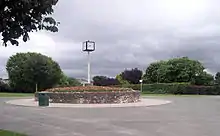Central Park, Plymouth
Plymouth's Central Park is a large centralised park situated to the north of Plymouth city centre in south west Devon, England, stretching north from the railway station to Pounds House, Peverell and west from Ford Park Cemetery to the A386 (Outland Road and Alma Road).

Central Park is trust land, which explains why it has not been built on in the middle of the city. The trust deed dedicated the land 'for municipal use' and as such it cannot be built on or developed, except for leisure purposes open to all. It is popular among walkers and joggers as it holds views all over the city to the sea.
The park is used mainly for sport and recreation: it has many leisure facilities such as football, rugby and cricket pitches, a golf course, a bowling green, a baseball diamond, Central Park Leisure Pools, Mayflower Leisure Centre and Home Park Stadium, home to Plymouth Argyle Football Club. In the mid 1990s, Plymouth Argyle had wanted to build a completely new 25,000-seat stadium in the area, but these were scrapped soon afterwards in favour of redeveloping Home Park.
There is also a new playground area, which is based on the continents of the world. This was demolished and rebuilt out of wood in 2018 as part of a £9 million redevelopment project for the park.

In 2007 the council opted to demolish the ageing Leisure Pools and Mayflower Leisure Centre rather than refurbish them, and replace them with a new larger combined indoor sports complex (Plymouth Life Centre) with multipurpose indoor pitches, basketball court, swimming pool and café.
By 2012 the Mayflower Leisure Centre and the Central Park Leisure Pools had been demolished, and the Plymouth Life Centre was officially opened on Saturday 24 March.[1] The multimillion-pound redevelopment has provided the city with greatly enhanced access to sport and leisure pursuits, and has finally brought all indoor activities under the one roof. The new facility gives a vastly improved aesthetic to the area, as the previous buildings were very tatty, rundown and poorly maintained.
However, the intricate steelwork which encased an external fire escape, was quickly found to emit a high pitched noise in high wind - drawing complaints for nearby residents. After many months of being shrouded with scaffolding and sheeting, a solution was found and recladding was completed.
References
- "Archived copy". Archived from the original on 8 October 2014. Retrieved 19 October 2014.CS1 maint: archived copy as title (link)